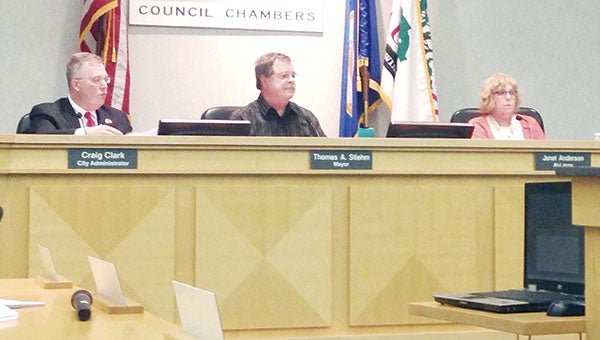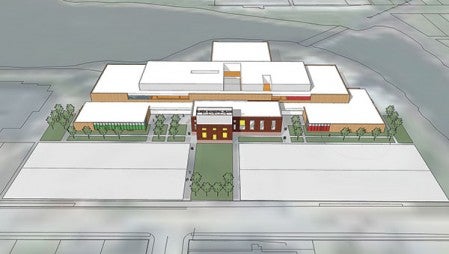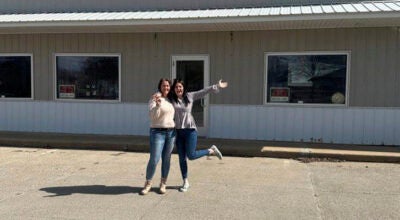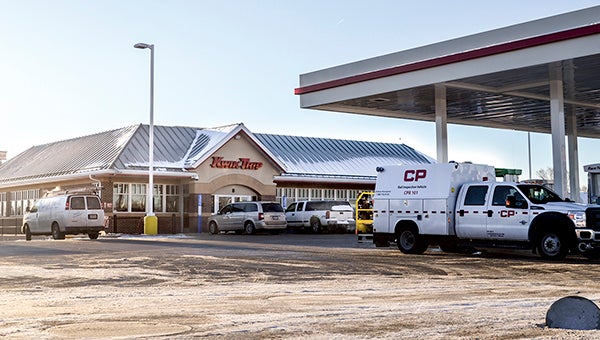No action on rec center; Plans receive support from council members
Published 10:21 am Tuesday, March 22, 2016

City Administrator Craig Clark, from left, Mayor Tom Stiehm and council member Janet Anderson at Monday night’s Austin City Council Meeting. Jordan Gerard/jordan.gerard@austindailyherald.com
The Austin City Council didn’t take action Monday on the proposal to build a $35 million Austin Community Recreation Center, but the plans received some support from council members and questions from others.
Some city officials praised Vision 2020’s proposal to build the rec center at the downtown Austin Municipal Plant during a council work session, calling it a project that would attract business and promote growth.
“That’s exactly the purpose of the whole [Vision] 2020 program and this is the flagship project of that program and that’s what we’re trying to do,” Mayor Tom Stiehm said. “We’re trying to entice people to come to Austin, bring jobs, bring their families and keep the people that work in Austin to stay in Austin. That’s the primary goal in all of these things.”
At the heart of Monday’s discussions were two proposals that would pave the way for the rec center, which would feature a new YMCA and public amenities. The first plan is a roughly $2 million purchase agreement for the city to acquire the former downtown plant from Austin Utilities; the second is a $200,000 a year operating agreement, which would last for 30 years, for the YMCA to manage the public portions of the rec center.
Vision 2020 Rec Center Committee co-chairs Tanya Medgaarden and Matt Cano gave a short history of the project since 2012 and highlighted the recent Wescott Athletic Complex project to add turf to both playing fields and a seasonal dome, which has been called the first step of the overall rec center project.
The facility would likely feature things like an indoor playground, a family aquatic center, a youth activity center and community spaces in the public rec center area along with gyms, a gymnastics facility, workout rooms, a running track and more in the YMCA portion.
Stiehm said such amenities are something employers look at when looking at towns.
Though Council member David Hagen said he’s heard a range of opinions from the community, he said the rec center will enhance Austin.
“A lot of people fight change,” Hagen said. “It would be attractive to employers. It would help spur growth in our economy and it will be a legacy for our families.”
Council member Steve King agreed.
“It’s an absolute gift and absolute opportunity,” King said. “If we don’t act on this … I don’t blame the Targets or Staples of this area to not live here. It’s too big of an opportunity to pass up. The spot is right on.”
Questions on operations
But other council members questioned the proposed $200,000 operating agreement the city would pay to the YMCA. Council member Michael Jordal said he doesn’t see $200,000 worth of public benefit, but he sees $200,000 in a new facility for YMCA members.
Council member Jeff Austin said he’s in favor of the rec center, but he said private interests could easily give the funds to Vision 2020 and the YMCA without the city being involved.
“Why is it necessary for the city to be a partner?” he asked.
The city wouldn’t fund any of the $35 million price tag to acquire the former plant or build the rec center. Vision 2020 has secured pledges for $25 million from The Hormel Foundation, $5 million from Hormel Foods Corp. and aims to raise $5 million in a capital campaign.
While Austin said the municipal plant is not his top choice for the site, he admitted it’s the only site investors — the Hormel Foundation and Hormel Foods Corp — will fund.
“The council has worked on this for months,” Austin said. “$200,000 is generous. As long as we can get that agreement worked out with the Y, I don’t have a problem with this going forward.”
Stiehm explained the $200,000 for the operating agreement would come out of the general fund, which would mean part of the costs would come from tax dollars.
“Lots of different things go into the [general] fund, including taxes,” Stiehm said. “So one can certainly make an argument that this $200,000 is going to come out of taxes. We want to be up front and clear about that. We can’t say, ‘No, this isn’t coming out of taxes.’”
He added for $200,000 and what the city is getting, it’s “well worth it.”
A look at the public spaces
Medgaarden said the committee has heard from non-YMCA members saying they want access to the facility, something she said Vision 2020’s research and surveys echoed.
“To go with just a Y would be a disservice to the citizens who are really looking for this type of space,” Medgaarden said.
She added the city is getting quite a bit for $200,000 a year and these are things citizens are asking for.
Stiehm said it’s clear Austin is likely getting a new YMCA with or without the city’s involvement, but the city is given an opportunity to partner with the project for community access.
Attorney Craig Byram explained some of what the community would be getting with the proposed $200,000 a year operating agreement between the city of Austin and the YMCA in the proposed recreation center, such as a minimum size requirement for a youth activity center.
“We wanted to make sure we were having these discussions,” Byram said. “The youth activity center would have something meaningful to the community that when youth went there, they would find it to be a suitable size, and if you look later in the agreement, there’s a description of what kinds of amenities will need to be provided there.”
He said there’s also a description of a children’s play area that needs to be at least 2,000 square feet, available to the public at no charge and the YMCA would have it cleaned, maintained and supervised. It would also have activities, popcorn and computers, things Byram said would set the minimum standards available to use in the community in exchange for that public investment of $200,000.
Byram said some things remain in negotiations but it gives “a flavor for what we as staff have tried to do to make sure $200,000 is something that would have value to members of the community, so it says the public has to have access to the walking track.”
The walking track is a part of the YMCA’s portion, but Byram and other city officials have made sure there will be times that it’s available to the public.
Byram said the aquatic center has to be open to the public at least 10 hours a day, which is more hours than the public pool is open, year round, at a daily charge.
Council member Jeremy Carolan asked if operating hours for certain parts, such as the walking/running track, would be adjustable.
The tentative plan calls for the public portions of the rec center to be available for a daily rate, but Council member Janet Anderson asked for an estimate of what the affordable day pass would cost and what would be accessible with it.
Medgaarden said Vision 2020 leaders likely won’t figure out that until it acquires a site and expands the initial operations plan.
“The thought is that it would be a reduced fee so it would be a benefit to the citizens to have that and that fee would allow them access to the entire facility, so if they wanted to go to the aquatic center that’s fine,” Medgaarden said.
Negotiations are ongoing for some public options, but Byram said people have to consider the Y is not generally required to have daily passes.
“Just the inclusion of a daily charge is beneficial to the community because people don’t have to pay a monthly fee or an annual fee to access that,” Byram said.
Byram added the city is communicating with the Y about it and are trying to make sure it’s less than the Y charges regularly for that access.
“We’re trying to make sure from a staff perspective that we get enough public bang for the buck, that you will all feel comfortable saying that that $200,000 is close enough connected to the kinds of benefits we’ve tried to accomplish here,” Byram said.
Byram said the agreement provides an opportunity for YMCA management and Austin Parks and Rec to meet monthly to get feedback from the community about how open hours for activities are working for them.
Byram added the main thing is to not increase the burden to the Y because the city is keeping its financial commitment at a stable amount and there is built-in flexibility to allow for changes to times or types of activities.
“It’s always an option to renegotiate if both parties weren’t happy with it,” Byram said. “What it says right now, is as long as Park and Rec’s opinion doesn’t materially increase the burden on the Y, the Y has to be responsive to the feedback it’s getting from the public about the types of activities that are offered in the hours they are being offered.”
Byram said it sets a level of expected service and within that level, it can be adjusted.
Better through partnerships?
City Administrator Craig Clark said $200,000 is a significant amount. However, he added it gets expensive to run such a facility and noted that “we’re better together” in partnerships.
Cano added there would be no way for the YMCA to build a $35 million facility on its own without the support of groups like the foundation, Hormel and the city.
“It’s a project larger than I.J. Holton [Intermediate School], The [Hormel] Institute,” Cano said. “It’s one of the largest projects out there. There’s no way the YMCA could do this alone and I don’t think the city has the [power] to do it tax-wise. We need to have the partnership together.”
King thanked Medgaarden and Cano for their efforts and energy given toward this project.
Austin Area Chamber of Commerce Executive Director Sandy Forstner said the Chamber supports the project.
“Progress has a price, so does stagnation,” Forstner said. “It’s a real opportunity.”
On Monday, the meeting room was sparsely populated with a few other community leaders, including Vision 2020 Director Greg Siems, YCMA Executive Director Tedd Maxfield, Quin Brunner, Austin Utilities General Manager Mark Nibaur, Development Corporation of Austin Director John Garry and Marv Repinski.
While Brunner and Anderson have led efforts to slow down the process and give the community more time to discuss potential uses for the downtown plant and potential locations for the rec center, many of those concerns did not come up on Monday.






